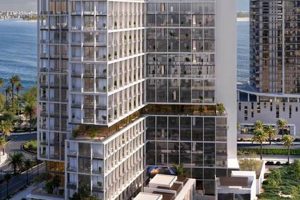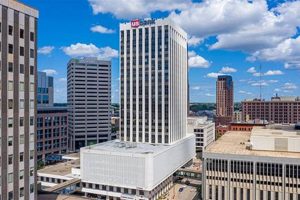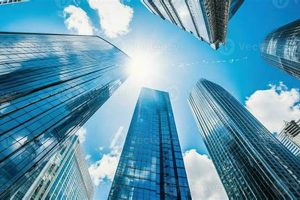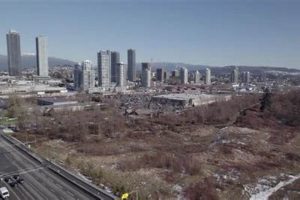Boston skyscrapers are high-rise buildings that are an iconic part of the city’s skyline. The first skyscraper in Boston was the Ames Building, which was completed in 1889. Since then, many other skyscrapers have been built in Boston, including the John Hancock Tower, the Prudential Tower, and the Copley Place Marriott. These buildings are home to offices, apartments, and retail stores, and they play a major role in the city’s economy and culture.
Skyscrapers have several advantages over other types of buildings. They can accommodate a large number of people in a relatively small space, and they can provide stunning views of the city. Skyscrapers can also be energy-efficient, as they can be designed to take advantage of natural light and ventilation. However, skyscrapers can also be expensive to build and maintain, and they can sometimes create wind tunnels and other problems at street level.
Despite these challenges, skyscrapers continue to be an important part of Boston’s skyline. They are a symbol of the city’s economic and cultural vitality, and they provide a unique perspective on the city.
1. Height
The height of Boston’s skyscrapers is a defining characteristic of the city’s skyline and a testament to its economic and architectural prowess. The Hancock Tower, completed in 1976, was once the tallest building in New England and remains one of the city’s most iconic landmarks. Its observation deck offers breathtaking panoramic views of Boston and beyond.
The height of Boston’s skyscrapers has several advantages. First, it allows for more efficient use of land, as tall buildings can accommodate more people and businesses in a smaller footprint. Second, tall buildings can provide stunning views, which can be a major selling point for residential and commercial tenants. Third, tall buildings can be more energy-efficient, as they can be designed to take advantage of natural light and ventilation.
However, the height of Boston’s skyscrapers also presents some challenges. First, tall buildings can be expensive to construct and maintain. Second, they can create wind tunnels at street level, which can be uncomfortable for pedestrians. Third, tall buildings can cast long shadows, which can block sunlight from reaching the streets below.
Overall, the height of Boston’s skyscrapers is a major factor in the city’s identity and economy. While there are some challenges associated with tall buildings, their benefits far outweigh their drawbacks.
2. Design
The design of Boston’s skyscrapers is a reflection of the city’s rich history and diverse architectural influences. From the Art Deco Prudential Tower to the modern glass-and-steel Millennium Tower, Boston’s skyscrapers represent a wide range of architectural styles.
- Historical Influences: Boston’s skyscrapers often incorporate elements of historical architectural styles, such as the Art Deco style of the Prudential Tower and the Gothic Revival style of the Custom House Tower. These historical influences add a sense of character and charm to Boston’s skyline.
- Modern Innovations: Boston’s skyscrapers also showcase modern architectural innovations, such as the use of glass and steel in the Millennium Tower and the Hancock Tower. These modern buildings are often designed to be energy-efficient and sustainable.
- Functional Considerations: The design of Boston’s skyscrapers is also influenced by functional considerations, such as the need for natural light and ventilation. Many Boston skyscrapers feature large windows and open floor plans to maximize natural light and reduce the need for artificial lighting.
- Aesthetic Appeal: In addition to their functional considerations, Boston’s skyscrapers are also designed to be aesthetically pleasing. The city’s architects have created a variety of unique and iconic buildings that contribute to Boston’s overall beauty and appeal.
The diverse range of architectural styles in Boston’s skyscrapers is a reflection of the city’s rich history, its embrace of modern innovations, and its commitment to creating a beautiful and livable city.
3. Function
Boston’s skyscrapers are not just architectural marvels; they are also hubs of economic and social activity. The diverse functions of Boston’s skyscrapers contribute to the city’s overall vitality and livability.
One of the most important functions of Boston’s skyscrapers is to provide office space. Many of the city’s largest employers, including financial services firms, law firms, and technology companies, are headquartered in Boston’s skyscrapers. This concentration of office space in skyscrapers helps to create a vibrant and dynamic business environment.
In addition to office space, Boston’s skyscrapers also provide a significant amount of residential space. Many Boston residents choose to live in skyscrapers because of their convenience, security, and access to amenities. Skyscrapers offer a variety of housing options, from luxury apartments to affordable units, making them a great option for people of all ages and income levels.
Boston’s skyscrapers also house a variety of retail stores and restaurants. This makes them convenient destinations for both residents and visitors. Many Boston skyscrapers have retail spaces on the lower floors, while others have rooftop restaurants and bars that offer stunning views of the city.
Finally, Boston’s skyscrapers are also home to a number of hotels. This makes them a convenient option for business travelers and tourists. Many Boston skyscrapers have luxury hotels that offer a variety of amenities, such as spas, fitness centers, and fine dining.
The diverse functions of Boston’s skyscrapers contribute to the city’s overall vitality and livability. They provide space for businesses to operate, residents to live, and visitors to stay. Boston’s skyscrapers are an essential part of the city’s fabric, and they play a major role in making Boston a great place to live, work, and visit.
4. History
The history of Boston’s skyscrapers is a story of innovation and growth. The first skyscraper in Boston, the Ames Building, was completed in 1889. It was a 10-story building that was considered to be a marvel of engineering at the time. In the years since, Boston’s skyline has been transformed by the construction of numerous skyscrapers, including the John Hancock Tower, the Prudential Tower, and the Copley Place Marriott.
- Archi
tectural Innovation: Boston’s skyscrapers have been at the forefront of architectural innovation. The Ames Building was one of the first buildings in the world to use a steel frame, which allowed for taller and stronger buildings. Boston’s skyscrapers have also been pioneers in the use of glass and other materials, which has led to the development of more energy-efficient and sustainable buildings. - Economic Growth: The construction of skyscrapers has played a major role in Boston’s economic growth. Skyscrapers provide much-needed office space for businesses, and they also attract residents and tourists to the city. The presence of skyscrapers has helped to make Boston a major center of commerce and culture.
- Changing Skyline: The construction of skyscrapers has had a profound impact on Boston’s skyline. The city’s skyline is constantly evolving, as new skyscrapers are built and older buildings are demolished. This process of change has created a unique and dynamic skyline that is one of Boston’s most iconic features.
- Cultural Identity: Boston’s skyscrapers are more than just buildings; they are also symbols of the city’s cultural identity. The John Hancock Tower, for example, is one of the most recognizable buildings in the world and is often used to represent Boston in popular culture. Boston’s skyscrapers are a source of pride for residents and visitors alike, and they play a major role in shaping the city’s identity.
The history of Boston’s skyscrapers is a story of innovation, growth, and change. Boston’s skyscrapers have played a major role in shaping the city’s economy, culture, and identity. They are a testament to the ingenuity and ambition of Boston’s architects and engineers, and they continue to be a source of pride for residents and visitors alike.
5. Economics
Boston’s skyscrapers are not just architectural marvels; they are also economic powerhouses. They provide much-needed office space for businesses, and they also attract residents and tourists to the city. The presence of skyscrapers has helped to make Boston a major center of commerce and culture.
- Job Creation: Boston’s skyscrapers provide jobs for thousands of people, both directly and indirectly. Construction workers, architects, engineers, and property managers are all involved in the construction and maintenance of skyscrapers. In addition, skyscrapers create jobs for tenants, such as office workers, retail employees, and hotel staff.
- Tax Revenue: Boston’s skyscrapers generate significant tax revenue for the city. This revenue can be used to fund essential services, such as education, public transportation, and public safety.
- Tourism: Boston’s skyscrapers are a major tourist attraction. Visitors from all over the world come to see the city’s iconic skyline and to visit its many attractions, such as the Skywalk Observatory at the Prudential Tower and the Top of the Hub restaurant at the John Hancock Tower.
- Economic Development: Boston’s skyscrapers have played a major role in the city’s economic development. They have attracted businesses to the city and helped to create a vibrant and dynamic economy.
Overall, Boston’s skyscrapers are major contributors to the city’s economy. They provide jobs, generate tax revenue, attract tourists, and promote economic development. Boston’s skyscrapers are an essential part of the city’s fabric, and they play a major role in making Boston a great place to live, work, and visit.
6. Culture
Boston’s skyscrapers are more than just buildings; they are also cultural landmarks. They offer stunning views of the city and serve as backdrops for events and celebrations.
- Architectural Icons: Boston’s skyscrapers are architectural icons that define the city’s skyline. They are often used in postcards, travel brochures, and other promotional materials. Skyscrapers such as the John Hancock Tower and the Prudential Tower are instantly recognizable symbols of Boston.
- Tourist Attractions: Boston’s skyscrapers are popular tourist attractions. Visitors from all over the world come to see the city’s iconic skyline and to visit its many attractions, such as the Skywalk Observatory at the Prudential Tower and the Top of the Hub restaurant at the John Hancock Tower.
- Event Venues: Boston’s skyscrapers are also popular event venues. Many of the city’s most prestigious events, such as the Boston Marathon and the Fourth of July fireworks display, are held in or around Boston’s skyscrapers.
- Cultural Significance: Boston’s skyscrapers have cultural significance beyond their architectural and economic value. They are symbols of the city’s history, progress, and ambition. Skyscrapers such as the Custom House Tower and the Ames Building are reminders of Boston’s rich architectural heritage.
Overall, Boston’s skyscrapers are important cultural landmarks that contribute to the city’s identity and appeal. They offer stunning views, serve as backdrops for events and celebrations, and are symbols of the city’s history and progress.
7. Sustainability
The connection between sustainability and Boston’s skyscrapers is becoming increasingly evident as architects and developers strive to create buildings that are not only aesthetically pleasing but also environmentally responsible. Sustainability encompasses a wide range of practices aimed at reducing the negative impact of buildings on the environment, including energy efficiency, water conservation, and the use of sustainable materials.
Boston’s skyscrapers are particularly well-suited for sustainable design due to their large size and high energy consumption. By incorporating sustainable features into these buildings, architects can significantly reduce their environmental impact. For example, the John Hancock Tower, one of Boston’s most iconic skyscrapers, has undergone a major renovation that included the installation of energy-efficient windows, lighting, and HVAC systems. These upgrades are expected to reduce the building’s energy consumption by 30%.
In addition to energy efficiency, Boston’s skyscrapers are also incorporating sustainable practices in other areas. The Copley Place Marriott, for example, has installed a rainwater harvesting system that collects rainwater for use in irrigation and other non-potable purposes. The building also features a green roof that helps to reduce heat gain and improve air quality.
The sustainability of Boston’s skyscrapers is not only beneficial for the environment but also for the building owners and tenants. Sustainable buildings are more energy-efficient, which can lead to lower operating costs. They are also more attractive to tenants who are increasingly seeking out sustainable spaces. In addition, sustainable buildings can contribute to LEED certification, which can provide additional financial benefits.
The trend towards sustainability in Boston’s skyscrapers is expected to continue in the years to come. As the city grows and the demand for office and residential space increases, architects and developers will need to find way
s to create buildings that are both sustainable and meet the needs of their tenants. Boston’s skyscrapers are a testament to the city’s commitment to sustainability, and they serve as a model for other cities around the world.
FAQs about Boston Skyscrapers
This section addresses frequently asked questions about Boston skyscrapers, providing concise and informative answers.
Question 1: What is the tallest skyscraper in Boston?
The tallest skyscraper in Boston is the John Hancock Tower, which stands at 790 feet tall.
Question 2: When was the first skyscraper built in Boston?
The first skyscraper built in Boston was the Ames Building, which was completed in 1889.
Question 3: How many skyscrapers are there in Boston?
There are over 100 skyscrapers in Boston, with more under construction.
Question 4: What is the most popular skyscraper in Boston for tourists?
The most popular skyscraper in Boston for tourists is the Prudential Tower, which offers stunning views of the city from its Skywalk Observatory.
Question 5: What are some of the green features incorporated into Boston skyscrapers?
Many Boston skyscrapers incorporate green features such as energy-efficient lighting and HVAC systems, rainwater harvesting systems, and green roofs.
Question 6: What is the future of skyscrapers in Boston?
The future of skyscrapers in Boston is bright, with continued demand for office and residential space. New skyscrapers are expected to be even more sustainable and incorporate the latest technologies.
We hope these answers have been helpful in addressing common questions about Boston skyscrapers. For more information, please refer to the other sections of this article.
Transition to the next article section:
In the next section, we will explore the history of Boston skyscrapers in more detail.
Boston Skyscrapers
Boston’s skyscrapers are iconic landmarks that offer stunning views, unique experiences, and a glimpse into the city’s rich history and modern architectural achievements. Here are a few tips to help you make the most of your exploration of Boston’s skyscrapers:
Tip 1: Visit the observation decks.
Many of Boston’s skyscrapers offer observation decks that provide breathtaking panoramic views of the city and its surroundings. The Skywalk Observatory at the Prudential Tower and the Top of the Hub at the John Hancock Tower are two of the most popular observation decks, offering 360-degree views from high above the city.
Tip 2: Take a guided tour.
Several Boston skyscrapers offer guided tours that provide insights into the history, architecture, and engineering behind these impressive structures. These tours are a great way to learn more about the skyscrapers and the role they play in the city’s skyline and economy.
Tip 3: Attend events and exhibitions.
Many Boston skyscrapers host events and exhibitions throughout the year, offering visitors a chance to experience these buildings in a unique and memorable way. These events may include art exhibitions, concerts, and even rooftop yoga classes.
Tip 4: Dine in a rooftop restaurant.
Several Boston skyscrapers feature rooftop restaurants that offer delicious cuisine and stunning views of the city. These restaurants provide a truly unforgettable dining experience, allowing you to enjoy a meal while taking in the beauty of Boston’s skyline.
Tip 5: Admire the architecture.
Boston’s skyscrapers showcase a wide range of architectural styles, from Art Deco to modern glass and steel. Take some time to appreciate the intricate details and innovative designs of these buildings, which have shaped the city’s architectural landscape.
Summary:
By following these tips, you can explore and enjoy Boston’s skyscrapers in a meaningful and memorable way. Whether you’re a tourist or a local resident, these iconic buildings offer something for everyone, from breathtaking views to unique experiences and a glimpse into the city’s rich history and architectural heritage.
Conclusion
Boston’s skyscrapers are iconic landmarks that define the city’s skyline, contribute to its economic vitality, and offer unique experiences for visitors and residents alike. From the historic Ames Building to the modern Millennium Tower, these architectural marvels showcase Boston’s rich history, architectural innovation, and commitment to sustainability.
As Boston continues to grow and evolve, its skyscrapers will undoubtedly play an increasingly important role in shaping the city’s identity and economy. By embracing sustainable design practices, incorporating innovative technologies, and offering a diverse range of uses, Boston’s skyscrapers will continue to be vibrant hubs of commerce, culture, and community.







